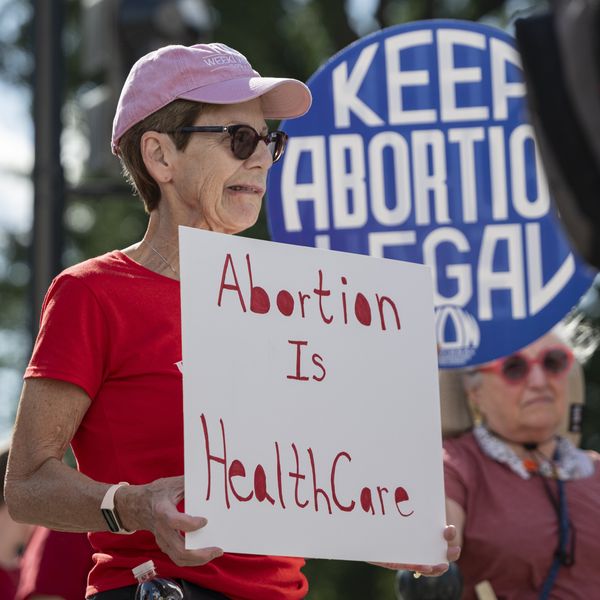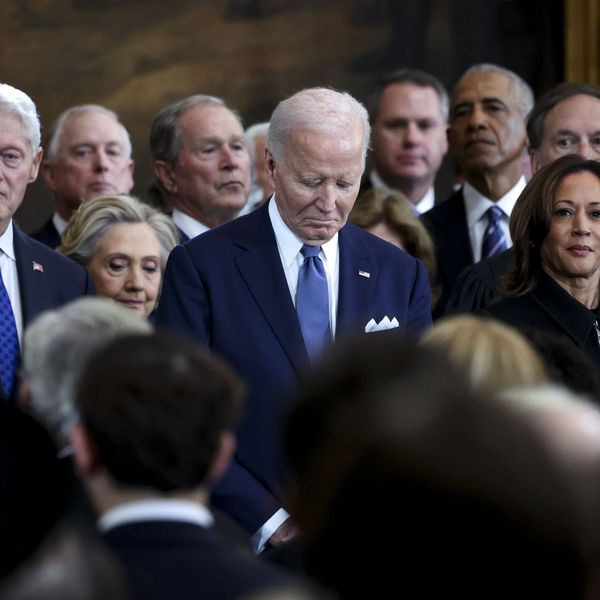As Abortion Restrictions Soar, Abortion Coverage Dwindles
Over the past decade, it has gotten much more difficult for women in the United States to access safe and legal abortion services, according to a new study by the Guttmacher Institute:
Over the past decade, it has gotten much more difficult for women in the United States to access safe and legal abortion services, according to a new study by the Guttmacher Institute:
Twenty-two states enacted 70 abortion restrictions during 2013. This makes 2013 second only to 2011 in the number of new abortion restrictions enacted in a single year. To put recent trends in even sharper relief, 205 abortion restrictions were enacted over the past three years (2011-2013), but just 189 were enacted during the entire previous decade (2001-2010).
These laws include restrictions on abortion providers, insurance coverage of abortions, and abortions themselves, among other things. The study continues:
In 2000, 13 states had at least four types of major abortion restrictions and so were considered hostile to abortion rights.... Twenty-seven states fell into this category by 2013.... The proportion of women living in restrictive states went from 31 percent to 56 percent, while the proportion living in supportive states fell from 40 percent to 31 percent over the same period.
How have national media kept up with this dramatically changing landscape? Not so well. According to a search of the Nexis news media database, coverage of abortion in the New York Times and Washington Post-the papers with the most influence on national political debates-have been trending downward since 2001.
The year 2011, which Guttmacher points out saw the most dramatic spike in terms of anti-choice policies, was the year that saw the least coverage in the New York Times and the second least in the Washington Post of the 13 years studied. Coverage bumped up in 2012, most likely as a result of the presidential elections and the "war on women" theme that was boosted by things like Missouri representative Todd Akin's infamous "legitimate rape" comment. (In the 2008 election, abortion was not a major focus of debate.)
It's possible that some of the downward trend can be attributed to a shrinking news hole, as papers adjust to dwindling revenues. But regardless of the cause, it's clear that readers aren't getting coverage that reflects the major shift in reproductive rights battles and access nationwide.
And as Sara McCloskey pointed out in her survey of 2013 abortion coverage (Extra!, 9/13), media priorities are clear: During the week and a half in which North Dakota passed some of the most restrictive abortion legislation in the country, national media mentioned the bills 207 times and March Madness basketball 1,407 times.
An Urgent Message From Our Co-Founder
Dear Common Dreams reader, The U.S. is on a fast track to authoritarianism like nothing I've ever seen. Meanwhile, corporate news outlets are utterly capitulating to Trump, twisting their coverage to avoid drawing his ire while lining up to stuff cash in his pockets. That's why I believe that Common Dreams is doing the best and most consequential reporting that we've ever done. Our small but mighty team is a progressive reporting powerhouse, covering the news every day that the corporate media never will. Our mission has always been simple: To inform. To inspire. And to ignite change for the common good. Now here's the key piece that I want all our readers to understand: None of this would be possible without your financial support. That's not just some fundraising cliche. It's the absolute and literal truth. We don't accept corporate advertising and never will. We don't have a paywall because we don't think people should be blocked from critical news based on their ability to pay. Everything we do is funded by the donations of readers like you. Will you donate now to help power the nonprofit, independent reporting of Common Dreams? Thank you for being a vital member of our community. Together, we can keep independent journalism alive when it’s needed most. - Craig Brown, Co-founder |
Over the past decade, it has gotten much more difficult for women in the United States to access safe and legal abortion services, according to a new study by the Guttmacher Institute:
Twenty-two states enacted 70 abortion restrictions during 2013. This makes 2013 second only to 2011 in the number of new abortion restrictions enacted in a single year. To put recent trends in even sharper relief, 205 abortion restrictions were enacted over the past three years (2011-2013), but just 189 were enacted during the entire previous decade (2001-2010).
These laws include restrictions on abortion providers, insurance coverage of abortions, and abortions themselves, among other things. The study continues:
In 2000, 13 states had at least four types of major abortion restrictions and so were considered hostile to abortion rights.... Twenty-seven states fell into this category by 2013.... The proportion of women living in restrictive states went from 31 percent to 56 percent, while the proportion living in supportive states fell from 40 percent to 31 percent over the same period.
How have national media kept up with this dramatically changing landscape? Not so well. According to a search of the Nexis news media database, coverage of abortion in the New York Times and Washington Post-the papers with the most influence on national political debates-have been trending downward since 2001.
The year 2011, which Guttmacher points out saw the most dramatic spike in terms of anti-choice policies, was the year that saw the least coverage in the New York Times and the second least in the Washington Post of the 13 years studied. Coverage bumped up in 2012, most likely as a result of the presidential elections and the "war on women" theme that was boosted by things like Missouri representative Todd Akin's infamous "legitimate rape" comment. (In the 2008 election, abortion was not a major focus of debate.)
It's possible that some of the downward trend can be attributed to a shrinking news hole, as papers adjust to dwindling revenues. But regardless of the cause, it's clear that readers aren't getting coverage that reflects the major shift in reproductive rights battles and access nationwide.
And as Sara McCloskey pointed out in her survey of 2013 abortion coverage (Extra!, 9/13), media priorities are clear: During the week and a half in which North Dakota passed some of the most restrictive abortion legislation in the country, national media mentioned the bills 207 times and March Madness basketball 1,407 times.
Over the past decade, it has gotten much more difficult for women in the United States to access safe and legal abortion services, according to a new study by the Guttmacher Institute:
Twenty-two states enacted 70 abortion restrictions during 2013. This makes 2013 second only to 2011 in the number of new abortion restrictions enacted in a single year. To put recent trends in even sharper relief, 205 abortion restrictions were enacted over the past three years (2011-2013), but just 189 were enacted during the entire previous decade (2001-2010).
These laws include restrictions on abortion providers, insurance coverage of abortions, and abortions themselves, among other things. The study continues:
In 2000, 13 states had at least four types of major abortion restrictions and so were considered hostile to abortion rights.... Twenty-seven states fell into this category by 2013.... The proportion of women living in restrictive states went from 31 percent to 56 percent, while the proportion living in supportive states fell from 40 percent to 31 percent over the same period.
How have national media kept up with this dramatically changing landscape? Not so well. According to a search of the Nexis news media database, coverage of abortion in the New York Times and Washington Post-the papers with the most influence on national political debates-have been trending downward since 2001.
The year 2011, which Guttmacher points out saw the most dramatic spike in terms of anti-choice policies, was the year that saw the least coverage in the New York Times and the second least in the Washington Post of the 13 years studied. Coverage bumped up in 2012, most likely as a result of the presidential elections and the "war on women" theme that was boosted by things like Missouri representative Todd Akin's infamous "legitimate rape" comment. (In the 2008 election, abortion was not a major focus of debate.)
It's possible that some of the downward trend can be attributed to a shrinking news hole, as papers adjust to dwindling revenues. But regardless of the cause, it's clear that readers aren't getting coverage that reflects the major shift in reproductive rights battles and access nationwide.
And as Sara McCloskey pointed out in her survey of 2013 abortion coverage (Extra!, 9/13), media priorities are clear: During the week and a half in which North Dakota passed some of the most restrictive abortion legislation in the country, national media mentioned the bills 207 times and March Madness basketball 1,407 times.

